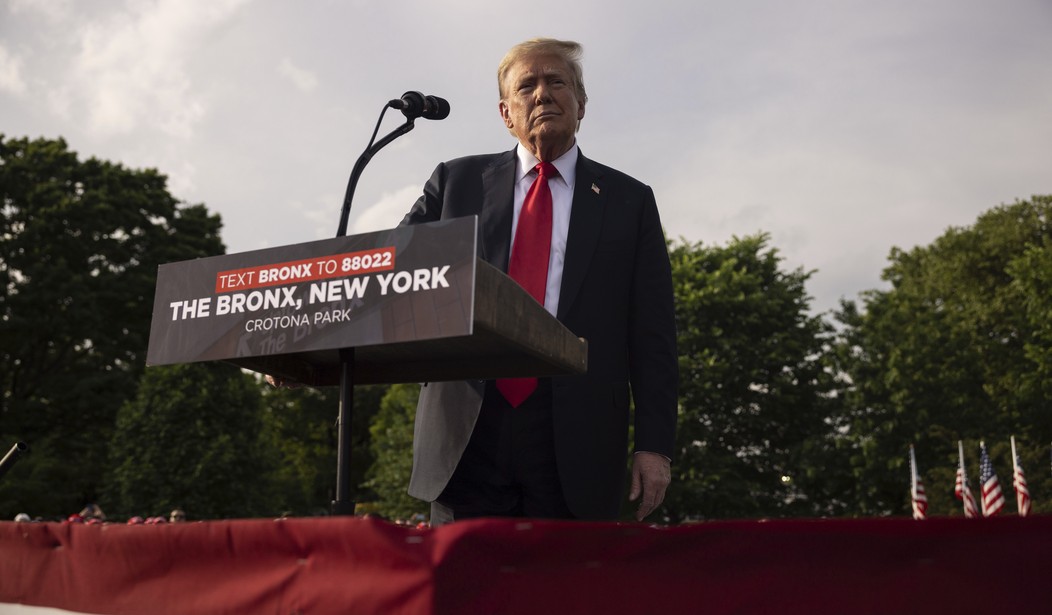Former President Donald Trump's rally in the Bronx borough of New York City on May 23 and his willingness to speak at the Libertarian convention on May 25 despite the hostility of some of the attendees highlight two notable differences between him and the establishment politicians in both the Republican and Democratic parties.
The first is Trump's willingness to speak to audiences outside his core constituencies.
Most Republicans and Democrats prefer their speaking engagements to be in front of an audience they are certain will be made up of supporters. Democrat candidates have received criticism for taking certain voting blocs for granted; the conventional wisdom after the 2016 presidential election was that Hillary Clinton paid insufficient attention to Rust Belt states like Wisconsin and Michigan and she lost to Trump. For their part, Republicans take flak for not even trying to get the support of groups that everyone assumes will vote "D," including Blacks, Hispanics, and immigrants.
While Trump loves an adoring crowd, he isn't afraid to step out of his comfort zone, and he's been doing it since his 2016 presidential campaign.
The second difference is the content of Trump's speeches. When he does address groups that have been traditional Democrat strongholds, his messaging stands in stark contrast to Democrats' constant harping on their voters' powerlessness and despair.
President Joe Biden's commencement address at Morehouse College on May 19 is a perfect example. Instead of inspiring and uplifting graduates of the historically Black college with reminders of their possibility, power, autonomy, and agency, Biden purported to read the minds of the students in the audience and claimed to see disillusionment and alienation:
"You started college just as George Floyd was murdered, and there was a reckoning on race. It's natural to wonder if the 'democracy' you hear about actually works for you. What is democracy if Black men are being killed in the street? What is democracy if a trail of broken promises still leaves Black communities behind? What is democracy if you have to be 10 times better than anyone else to get a fair shot? And most of all, what does it mean, as we've heard before, to be a Black man who loves his country even if it doesn't love him back in equal measure? ... They don't see you in the future of America. But they're wrong."
Recommended
Biden's definition of democracy is depressing.
By contrast, Trump's remarks at his Bronx rally were filled with hope. He appealed to the historic toughness of New Yorkers, their loyalty to and love for their city, their resilience, and their ability to rebound and rebuild. Trump reminded them of their history, their potential, and the infinite possibilities when Americans work together.
In addition to appreciating Trump's positivity, some in the audience further noted that Trump didn't show up and pander to the crowd by promising goodies from the federal government or affecting some parody-worthy accent as a sign of false solidarity. (On the campaign trail in 2012, then-Vice President Biden told an audience of Black Americans that Republicans were "gonna put y'all back in chains." Hillary Clinton's cringeworthy affectation of a southern Black accent in her 2007 speech in Selma, Alabama, was even worse: "Ah don't feel no ways tahrred.")
Instead, Trump was Trump, with his usual, distinctive speaking style, cadence, and rhetorical flourishes.
Many of the Bronx rallygoers not only commented favorably on Trump's message but expressed their disgust with the policies of the Biden administration (which is to say: the policies of the Democrat Party) that are destroying the country: the tolerance of crime and violence; the political persecutions; the influx of millions of illegal immigrants (plenty of the Bronx residents immigrated to this country legally) and the handouts of billions of taxpayer dollars hard-earned by American citizens to pay for them; the crushing of our energy sector and resulting skyrocketing prices of gas and groceries; the inflation and erosion of purchasing power.
Bronx rally attendees and plenty of broadcast, print, and social media commentators noted that no Republican presidential candidates had visited the Bronx since Reagan -- the last Republican presidential candidate to win the state of New York.
A portent of things to come? Maybe.
It isn't just the contrast with Biden's speeches and the message of his comrades in Congress and elsewhere. It's the fact that so many of those at the Bronx rally arrived merely curious and left converted.
It's the fact that the Bronx rally came on the heels of Trump's rally in deep-blue New Jersey on May 12 that broke records, with over 100,000 people in attendance.
It's Trump's crossover appeal to minorities, immigrants, and working-class Americans. The Bronx is as ethnically diverse as it gets: 57% Hispanic, 28% Black, 4% Asian and about 8% white. It has long been considered a safe bastion of Democrat voters. But the incredibly diverse crowd of people who came to see Trump speak in the Bronx's Crotona Park were proud to be told they are Americans first and foremost.
Traditional politicians have long utilized the old technique of "divide and conquer"; to the extent they can keep Americans fighting with each other, the power is theirs for the taking. Instead of dividing people by referencing their differences, Trump reminds people of the power they have; how their differences can make the group stronger if they are working together on a common goal.
In other words, it's Trump who is the unifier.
Can Trump flip the Bronx? Can he flip New Jersey? Can he get record-breaking support from the country's Black and Hispanic population?
Are we looking at the possibility of a Reaganesque landslide?

























Join the conversation as a VIP Member